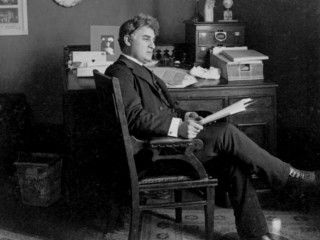
David Belasco biography
Date of birth : 1853-07-22
Date of death : 1931-05-14
Birthplace : San Francisco, California, U.S.
Nationality : American
Category : Famous Figures
Last modified : 2011-02-17
Credited as : theatrical director-producer , and playwright,
David Belasco, American theatrical director-producer and playwright, attempted to bring veracity to the popular melodrama through meticulous detail in setting and lighting. He led in the movement that made the director the theater's dominant personality.
David Belasco was born in San Francisco, Calif., on July 22, 1853. He was educated in a monastery, which may have prompted the quasi-clerical garb he wore in later life—a style that earned him the name "the Bishop of Broadway." He fled the monastery and joined a circus. By the age of 12 he was an actor on the San Francisco stage and had begun writing plays. In the following few years he joined companies barnstorming through the mining camps. In Virginia City, Nev., he served as secretary to Dion Boucicault, who inspired Belasco to try playwriting again. From 1873 to 1881 he was associated with several San Francisco theaters. His first play to attract attention was a collaborative effort with James A. Herne, Hearts of Oak. At 29 Belasco left for New York City, having acted more than 170 roles and written or adapted more than 100 plays.
His first position in New York was as a stage manager of the Madison Square Theater. In 1886 he became dissatisfied and joined the Frohmans as stage manager and house playwright. In 1890 he became an independent producer; his first real success was his own The Heart of Maryland, a melodrama inspired by the poem "Curfew Must Not Ring Tonight." Belasco took unknowns and turned them into stars. The first of these, Leslie Carter, had suffered through a sensational divorce. Penniless, a social outcast, she came to Belasco, who trained her and then starred her in Maryland. It played for three seasons and was then taken to London.
During the 1890s the Theatrical Syndicate gained control of the theatrical world and individuals who refused to join found themselves with no theaters. In Washington, D.C., Belasco was forced to rent the barnlike Convention Hall, leaky roof and all, for his production of Andrea with Carter. During the fourth act there was a violent rainstorm, and the audience observed the play from under their umbrellas. In 1902 Belasco gained control of the Republic Theater in New York. In 1906 he began work on a new building on West 44th Street, which eventually became the Belasco Theater.
In addition to Carter, Belasco elevated David Warfield (a vaudeville entertainer), Lenore Ulric, Frances Starr, and Blanche Bates to stardom. Most of these stars had natural ability, but Belasco was also a master at handling publicity campaigns. Certainly Carter's past was in part responsible for her success. Belasco also preferred to work with unknown playwrights. He collaborated with John Luther Long to write Andrea, Madam Butterfly, and Darling of the Gods; and with Henry C. DeMille on Lord Chumley and The Wife, among others. Madam Butterfly and Belasco's own The Girl of the Golden West were later adapted as the librettos for the Puccini operas.
Belasco claimed to have been associated with the production of nearly 400 plays, most of them written or adapted by himself; but his writing, in a time when lbsen, Strindberg, and Chekhov were introducing realism, remained filled with sensational melodrama or maudlin sentiment. His plays have virtually no lasting value. His advances in realism were in technical aspects of theater; his settings were accurate to minute detail, for rather than recreate a specific setting he preferred to buy it and then move it on stage. He particularly excelled in spectacular effect and in amazing mechanical contrivances. In lighting, he pioneered the use of color silks and gelatin slides, loving to create "real" sunsets. Also, in a day when productions were hurriedly put together, Belasco took time to perfect his work; even his most severe critics admit a "tidiness" not often found on the American stage. He excelled in creating a mood and tension in his crowd and mob scenes. Moreover, whatever was seen on stage was Belasco and the other artists were the instruments of his will. He died in New York on May 14, 1931.
















